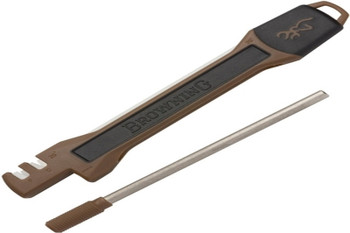What Is the Best Knife Sharpener? Choosing the Best to Fit Your Needs
May 2nd 2019
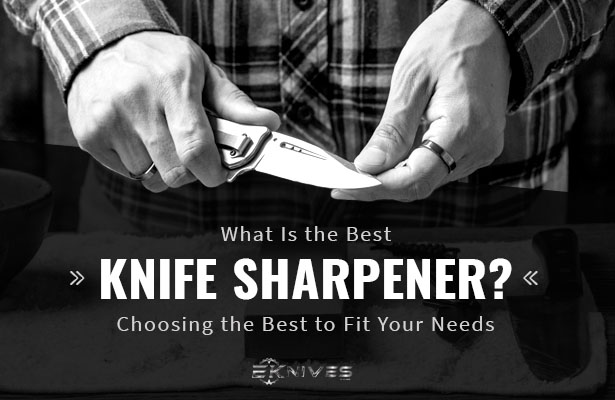
A dull knife is not only ineffective, but also dangerous. Dull blades require additional pressure to perform standard tasks, from cutting to piercing, which can increase your risk of injury and quickly wear down the blade or mechanism.
Sharpening your knife as part of a regular care and maintenance routine ensures your EDC knives and custom collectibles stay in top condition and ready for use when you need them most.
Find the Best Pocket Knife for You
.ctaBtn {background:#000;color:#fff;display:table;margin:0 auto;padding:20px;font-weight:700;border:1px solid #000;text-align:center;text-decoration:none;}.ctaBtn:hover {background:#fff;color:#000;}
There are numerous ways to sharpen your knife and a wide variety of sharpeners to suit each blade. Choosing the right method and tools cuts down your sharpening time and minimizes any damage to your knife.
Types of Knife Sharpeners
Whetstones
The sharpening tool of choice for the serious knife enthusiast is a whetstone. These gritty, rectangular blocks can be made from either synthetic or natural materials and used dry or with oil or water to sharpen and reprofile blades. It requires practice and patience to master the correct sharpening technique to use whetstones, so these tools are suitable for collectors, hunters and other avid knife users. They come in three general categories.
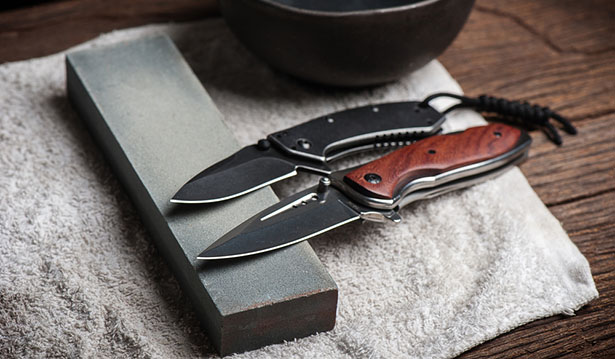
1. Oil Stones
Oil stones are the most common type of whetstone available. They are often made from naturally quarried novaculite, or synthetic aluminum oxide and silicon carbide. Oil stones are porous and designed to absorb mineral oil, which acts as a lubrication when sharpening. This minimizes a build-up of swarf to maintain a consistent cutting surface.
2. Waterstones
Traditional Japanese waterstones are composed of fine silicate grains embedded in a clay-like rock. This gives them a softer sharpening surface than other whetstones and makes for faster sharpening times. These highly porous stones need to be soaked in water for at least 20 minutes before use. Soaking allows the water to fill the pores in the stone, creating a smooth grinding surface.
Waterstones tend to wear down faster than other whetstones, so you need to perform regular reshaping. However, they are easy to clean and can help you sharpen your knives quickly.
3. Diamond Stones
Diamond stones are composed of fine diamond particles mounted on a metal plate. There are two varieties of diamond stones. The first, interrupted diamond plate, features small holes that collect the swarf to allow for exceptionally fast sharpening. The second, continuous diamond plate, has a flat diamond surface that is better suited for pointed blades that may get caught in the holes of interrupted diamond plates.
Diamond stones are often more expensive and longer-lasting than other types of whetstones.
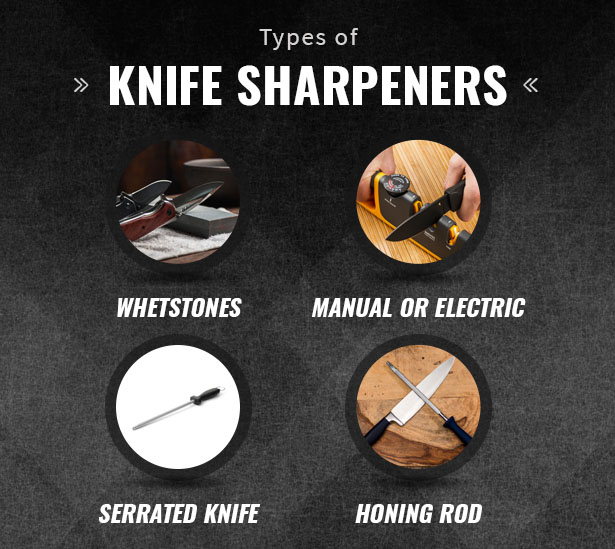
Manual or Electric Sharpeners
Best suited for kitchen knives or quick, weekly touch-ups for your pocket knife, a manual or electric sharpener is a fast and efficient way to keep your steel razor-sharp.
Check Out Our Collection of Microtech Knives
.ctaBtn {background:#000;color:#fff;display:table;margin:0 auto;padding:20px;font-weight:700;border:1px solid #000;text-align:center;text-decoration:none;}.ctaBtn:hover {background:#fff;color:#000;}
A manual sharpener consists of a V-shaped grinding notch in a protective housing while electric models typically feature a rotating wheel. To refine the edge on your blade, simply pass the knife through the notch several times and the grinding surface creates a new edge. The sharpening angle is pre-set on most models, making them easy to use and an ideal tool for beginners.
Serrated Knife Sharpeners
Unlike standard pocket knives, a serrated knife needs a specialized tool for sharpening the numerous teeth along the blade edge. A serrated knife sharpener is usually slender compared to standard tools. Serrated knife sharpeners have a similar shape to a honing steel, which helps them to better access and sharpen each tooth separately.
If you have a knife that has a combined straight and serrated edge, such as the LUDT series of Microtech knives,you will need a sharpening kit that contains tools for maintaining each type of blade.
Honing Rod
A honing rod isn’t technically a sharpener. This ceramic or metal rod is used to keep the blade even between sharpening sessions. It is ideal for use immediately before any cutting or slicing tasks, making it an essential tool for hunters and chefs.
You hone your blade by drawing each side of the blade across the surface of the rod three to four times. This straightens a slightly bent blade without removing any of the steel. If you have valuable custom knives, such as a Microtech OTF,a honing rod should be included in your sharpening kit to minimize the frequency with which you need to sharpen your blade.
Features to Look for
When shopping for a sharpener for your knife collection, there are several key features to look for in order to find the right sharpener for your needs.
Grit
Grit refers to the coarseness of the grinding surface, and most sharpening tools come with two or more grit sizes. Grit can be broadly divided into three levels: coarse, medium and fine.
Coarse grit stones are labeled as less than 1,000 grit. They are designed for removing deep nicks and chips and are ideally suited for heavy restoration jobs and blade reprofiling.
Medium grit stones range between 1,000 and 3,000 grit and are suitable for regular sharpening work. These stones restore the edge to dull blades, but will not repair extensive damage.
Fine grit sharpeners are similar to honing steel with a grit level between 4,000 and 8,000. These tools are primarily used as a finishing surface to refine knife blades.
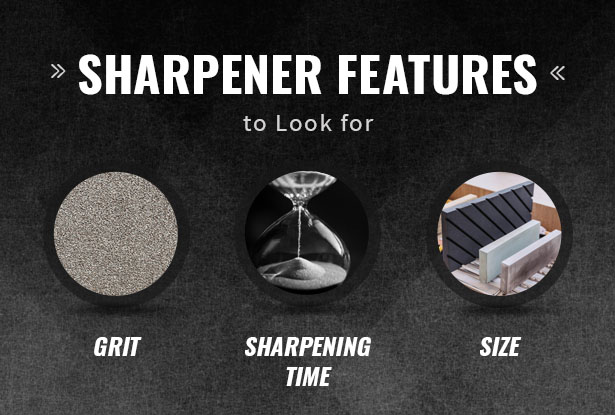
Size
The size of your sharpening tool can impact the speed at which it works and the surface area of the grinding plate. Sharpener size also determines the tool’s portability and countertop footprint–important factors to consider if you are looking for a sharpener to take into the field while hunting or to be a space-conscious addition to your kitchen.
A longer, wider whetstone provides a faster sharpening experience and usually lasts longer than smaller whetstones. However, if you need a sharpener for field dressing, a compact, multipurpose pocket knife sharpener–that includes multiple grit surfaces and a honing rod–is the ideal solution.
Sharpening Time
Ideally, you should sharpen, or at least hone, your knife before every use, but for many knife users, the time commitment needed to grind and polish the blade is too large to allow for frequent sharpening. When looking for a sharpening tool for your knife collection, it is important to consider how quickly the tool works, which is impacted by the tool’s size, shape and grind surface.
Diamond-plated whetstones offer the fastest sharpening time, making them ideal for quick touch-ups before performing cutting tasks. Oil and waterstones can produce a more refined edge than diamond-plated whetstones, but require more grinding time and more frequent cleaning and resurfacing. These traditional-style whetstones are suited for the routine maintenance for knife collections or before storing your knives.
How to Sharpen a Knife
Even the best pocket knife steel needs frequent sharpening to maintain its edge. A regular maintenance program and basic knowledge of how to sharpen a pocket knife are essential to ensure your knives stay in good condition and perform properly when you need them most.
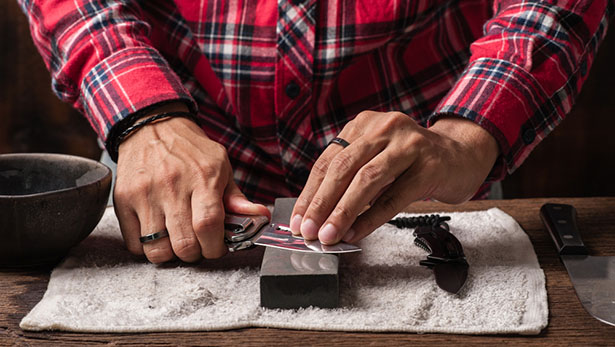
While manual pull-through and electric sharpeners are suitable for beginners and require little to no experience to use, sharpening with a whetstone requires careful technique and practice to avoid damaging the blade.
Before sharpening your knife, begin by cleaning the blade and handle with mild soap and water to remove any debris.
Start with the coarsest grit side of your whetstone and apply a thin film of lubricant or soak in water as instructed by the whetstone manufacturer.
Place the blade at the front of the whetstone with the edge facing away from your body. Hold at a 15-degree angle, using a bevel guide if necessary, and drag the blade towards you 10 to 15 times while applying moderate, even pressure. Flip the blade over and repeat on the other side. You should feel a raised burr on the unsharpened side of the blade, which indicates it is ready to be flipped.
Perform 10 to 12 more strokes, alternating each side, until there is a small burr on each side of the blade and then switch to the fine grit side of the whetstone and repeat the process. Polish the blade and handle with mineral oil to achieve a brilliant shine and add a protective coating.
Which Is Better: Wet or Dry Sharpening?
When it comes to sharpening, many knife owners debate about the relative merits of wet stone vs. dry stone techniques.
Typically, experts recommend you use either oil or water to lubricate the stone before sharpening, as this helps to remove swarf that would otherwise build up and scratch the blade. The lubricant also prevents the whetstone from clogging, providing a clean grinding surface that offers more consistent sharpening results.
In terms of health and safety, lubricated whetstones prevent swarf particles and whetstone dust from rising into the air and potentially getting into your eyes and airways.
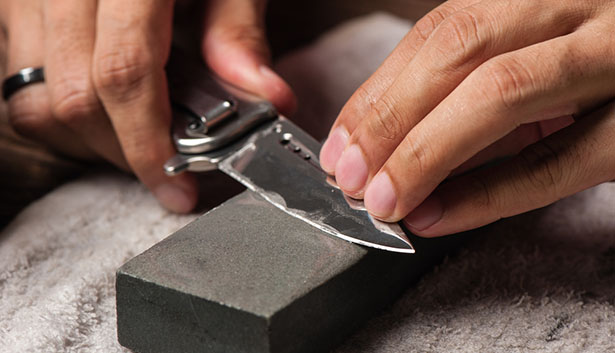
However, many knife owners are tempted to use their whetstones dry, as the lack of lubricant logically creates more friction for a faster sharpening experience and reduces clean-up time as you can simply dust off the whetstone after you are done. Unfortunately, this friction also generates heat, which can warp and damage the blade throughout the sharpening process.
Diamond-plated whetstones with non-continuous surfaces are the only sharpening tools that do not require lubrication. The hard diamond particles do not break off, and the holes in the stone collect the swarf dust to keep the grinding surface clear so as not to impede the sharpening action.
Storing Your Knives
Sharpening your knives before each use improves the performance and efficiency of the blade. It is also an important part of routine knife maintenance to prolong the life of your collection.
Storage is an essential part of caring for your knives, too. The right storage prevents the build-up of dust and debris to minimize the need for frequent sharpening. There are several options available–depending on whether you want a permanent storage and display unit or a portable storage solution that protects your EDC knife.
Sheath
Suitable for fixed blade knives, a sheath provides protection and easy accessibility for fast deployment. Modern sheaths are made primarily from tough Kydex, although leather sheaths have a more traditional look and still provide ample protection.
Pouch
A pouch is designed to fit a single folding knife when used for EDC. It protects the handle and locking mechanism from debris found in a pocket or bag and reduces the risk of accidental in-pocket opening.
Knife Roll
A knife roll is a suitable, portable option for storing both fixed blade and folding knives. A high-quality knife roll should have secure fasteners, such as high-tension elastic, and a soft fabric interior to prevent the knives from becoming nicked or scratched. The exterior of the knife roll should feature a durable, rugged material to protect your collection from the elements.

Storage Case
A lockable, glass-fronted storage case is the perfect choice for the avid collector and allows you to put your freshly sharpened blades on display. Choose a case that is lined with foam or fabric to protect fragile accents on the handle, such as inlays or metalwork embellishments. If you have a Damascus steel knife, ensure the interior of the case is acid-free to prevent staining and corrosion.
The Round-Up
The best knife sharpener for your needs depends on a variety of factors, from the type of knife you carry to the frequency with which you sharpen it. Knives should be sharpened before storage and before every use. If you have an EDC knife, you may consider keeping a compact, portable sharpener and honing rod handy to optimize the blade performance.
Alternatively, a whetstone is an ideal choice of tool for maintaining your knife collection or sharpening your knives at home. Whetstones can help you achieve a refined, razor-sharp edge and give you control over the sharpening process. However, sharpening with a whetstone requires practice and patience to learn the correct technique.
At eKnives, we carry a huge range of high-quality knives from some of the best knife makers in the business. Browse our online catalog or contact us at (423) 525-9477 to find out more about our selection of high-performance custom knives and accessories.

